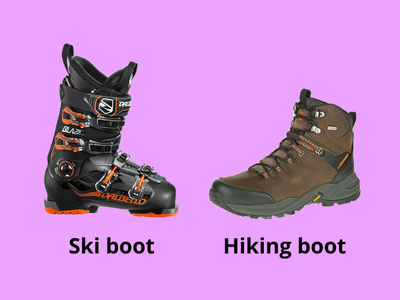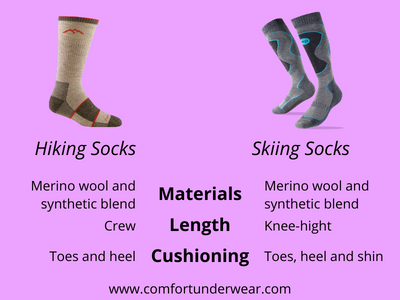Socks play an important role in the comfort of activities such as hiking and skiing. In both sports, we are on our feet for hours, and our feet are exposed to a lot of stress. In this post, I will discuss whether hiking socks are suitable for skiing.
Hiking socks can also be suitable for skiing. Because hiking socks and ski socks are made of the same materials. If you are wearing hiking socks for skiing, it is recommended that the socks reach to the knees. This protects your shin from being hit by the ski boot.
In the rest of this post, I’ll tell you what to look out for if you want to wear hiking socks for skiing. What are the important factors that determine the quality of a sock and how to take care of your hiking and ski socks?
are hiking socks good for skiing?
Hiking socks are fine for skiing. However, there is one important feature to consider that can have a big impact on comfort while skiing. This is the length of the sock.
If the sock is too short, your shin may start to hurt as your foot often hits the ski boot while skiing. This is why ski socks are usually knee-length. Some ski socks even have extra cushioning in the shin area.

Ski boots are higher than hiking boots, so ski socks tend to come up to the knees. If you have hiking socks that are shorter than your ski boots, this can be a problem. When skiing, our feet move around a lot and lean on our ski boots. Ski boots are made of hard plastic, and even though they are lined on the inside, our legs can start to hurt when skiing for several hours. The most exposed part of the leg is the shin, which puts a lot of pressure on the ski boot. For this reason, ski sock manufacturers have also made socks that are additionally padded in the shin area.

Hiking socks have the same properties as ski socks.
- They are made of thick fibers, which makes hiking or skiing more comfortable.
- They are made of absorbent materials to keep the foot dry for longer and prevent fungi and bacteria.

When choosing ski socks, it is important to ensure they are elastic enough and fit snugly against the foot. Socks that are too big start to wrinkle as the feet move in the ski boots. This increases the friction of the foot against the boot, which can lead to blisters more quickly.
As I mentioned, the length of ski socks is also important. Ski boots are higher than hiking boots, so knee-high socks are worn for skiing to protect the shin from shocks. Avoid wearing hiking socks that are crew length, as this can be very painful.
You can read more about what makes hiking socks special and how they differ from ordinary socks here.
How to choose quality hiking and ski socks
Hiking socks and ski socks are very similar in many ways. Both are made from similar materials and are very durable, comfortable, soft, and long-lasting. The factor that has the biggest influence on whether socks are of good quality is the material. Then there is also how often they are worn and how they are cared for (more on this below).
You can save a lot of money and wardrobe space if you also use hiking socks for skiing, so you don’t need to buy special ski socks. In a previous post, I wrote about whether we can wear running socks for walking. You can read the full post here.
Choice of quality materials
The best material for hiking and ski socks is merino wool. Merino wool has many positive properties:
- it is very comfortable and soft, which makes it easier to wear for long periods of time,
- it absorbs 60% of its own weight in moisture,
- although it absorbs a lot of moisture, it stays dry to the touch,
- it is a very good insulator, keeping us from getting cold in winter and hot in summer.
Merino wool is also elastic, but not enough for the needs of hiking and ski socks, which need to be elastic enough to grip the foot well. Otherwise, blisters can form. For this reason, synthetic materials are usually added to the mix of materials. Nylon and elastane are the most common, giving hiking and ski socks the elasticity they need.
Nylon also has the good property of absorbing a lot of moisture, unlike other synthetic materials. So your feet will stay dry for longer when hiking or skiing.
When shopping for hiking or ski socks, they should contain at least 60% absorbent materials (merino wool, nylon). If the socks are made of 63% merino wool, 35% nylon, 2% elastane, that’s great.
How to take care of hiking and ski socks?
Merino wool is heat sensitive, so washing in hot water and tumble drying can cause merino wool socks to shrink. To avoid this, you can hand wash hiking and ski socks in cold water, choose the hand wash program for washing in the washing machine, or just choose the cold water program (20-30 °C).
Socks shrink in hot environments because the fibers are damaged. They can also be damaged by washing in cold water. Therefore, turn all socks around before washing them. This will protect the outer fibers of the socks. For extra protection and to prevent the socks from being lost in the wash, you can use an underwear wash bag. Instead of tumble drying, hang all types of socks on a drying rack.

